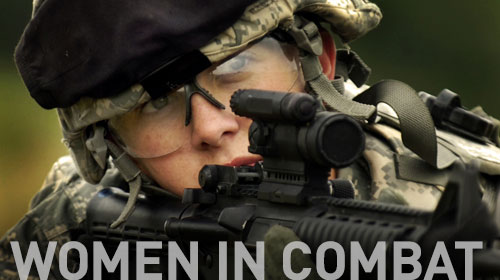
On January 24, 2013, we saw a great victory for U.S. servicewomen when the Department of Defense announced it was ending the ban on women serving in combat units and occupational specialties. As the Pentagon and the armed services begin implementing the change in policy, there are many issues that must be resolved, and we'll be keeping a close eye on the process. In an ongoing blog series, we will bring you voices of military experts, veterans, and other stakeholders who will discuss these issues and the need to fully integrate women in the armed forces.
Today marks an important milestone for US servicewomen: Defense Secretary Chuck Hagel is scheduled to receive detailed plans from the Services showing how they will implement the Pentagon's repeal of its policy prohibiting women from serving in ground combat units and jobs.
Like many others who have long argued against the old exclusionary policy, I'll be watching the process and encouraging the Pentagon and the Services to truly bury the old policy and move swiftly towards the full (not a partial or half-hearted) integration of women into our armed forces.
But, to my dismay, there are still those who criticize the Pentagon's decision to end the ground combat exclusion policy. Their arguments are often based on a worn ideology about the role of women and a lack of knowledge or appreciation of the contributions servicewomen have already played in combat operations.
For example, some argue that direct ground combat goes beyond the experience of being "in harm's way." That's true, but what the naysayers don't understand is that women have been going far beyond being "in harm's way" throughout the duration of the Iraq and Afghanistan wars. In reality, thousands of women have engaged in ground combat since the early days of those wars. These women continue to live in the field under the same conditions and carry out the same duties as the men.
Women have served almost 300,000 tours of duty in the Iraq and Afghanistan theatres of war. Over 150 have given their lives, more than 865 have received Purple Hearts, and two have earned Silver Stars for valor under fire. Women have been and continue to be in ground combat, and they have earned the right to serve officially in ground combat units.
Another criticism is that tough combat training standards will be lowered by making them "equal" for both genders. I have one thing to say to that: baloney.
Women have already been integrated into air and sea combat duties with no lowering of standards. Occupational standards—be they medical, intellectual, or physical—should be, and one hopes are, based solely on what is actually required for individuals to perform the occupational tasks successfully in combat.
It's also worth noting that many critics confuse the armed services' physical fitness standards, which are normed by age and sex and vary from service to service, with occupational or combat fitness standards. Physical fitness standards are measures of individual fitness only and are not used to determine fitness for any specific military occupations. Occupational standards, which are under discussion when we are talking about women entering ground combat occupations, are the same regardless of age or gender, as should they be.
Women and men are currently held to the same occupational standards for all military occupational specialties and Navy ratings. Men and women serving in aviation and naval combat occupations meet identical occupational standards. Furthermore, they meet identical standards to graduate from physically demanding training courses such as SERE training and the Army's very tough Sapper Leaders Course. Why would this precedent change for ground combat occupations?
Let's be clear: opening ground combat to women isn't about "equal opportunity" or "diversity." It's about enhancing our national security and our warfighting capability. It's about giving every soldier, sailor, airman, or Marine the opportunity to use her individual skills and achievements to serve her country.
Women from this country (and many countries) have proven themselves as effective combatants in the current wars and in wars throughout history. It's time the naysayers put their outmoded stereotypes of what a servicewoman can or cannot do to rest. A new day has dawned.
Captain Lory Manning, USN, (Ret.) served for more than 25 years in the U.S. Navy. She was a telecommunications specialist who commanded Naval Computer and Telecommunications Station, Diego Garcia, (in the remote British Indian Ocean Territory) with a mixed-gender crew of over 350 people. During her final tour of active duty, she served as Deputy to the Assistant Chief of Naval Personnel for Personal Readiness and Family Support where her varied responsibilities included oversight, development, and continuing evaluation of the Navy's physical fitness standards Captain Manning serves as the director of the Women in the Military Project at the Women's Research & Education Institute in Washington, DC.
Learn more about women in the military and other civil liberty issues: Sign up for breaking news alerts, follow us on Twitter, and like us on Facebook.




